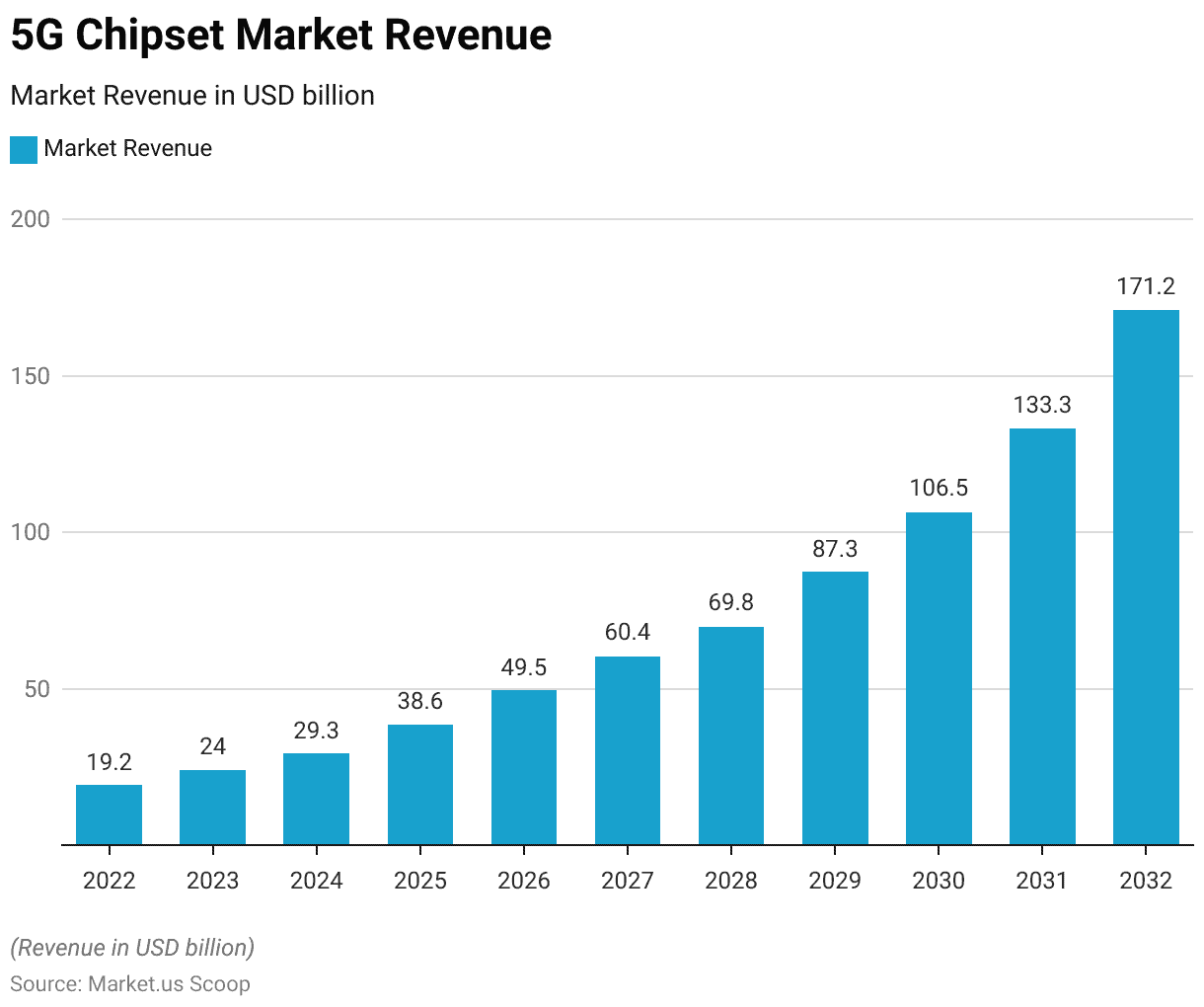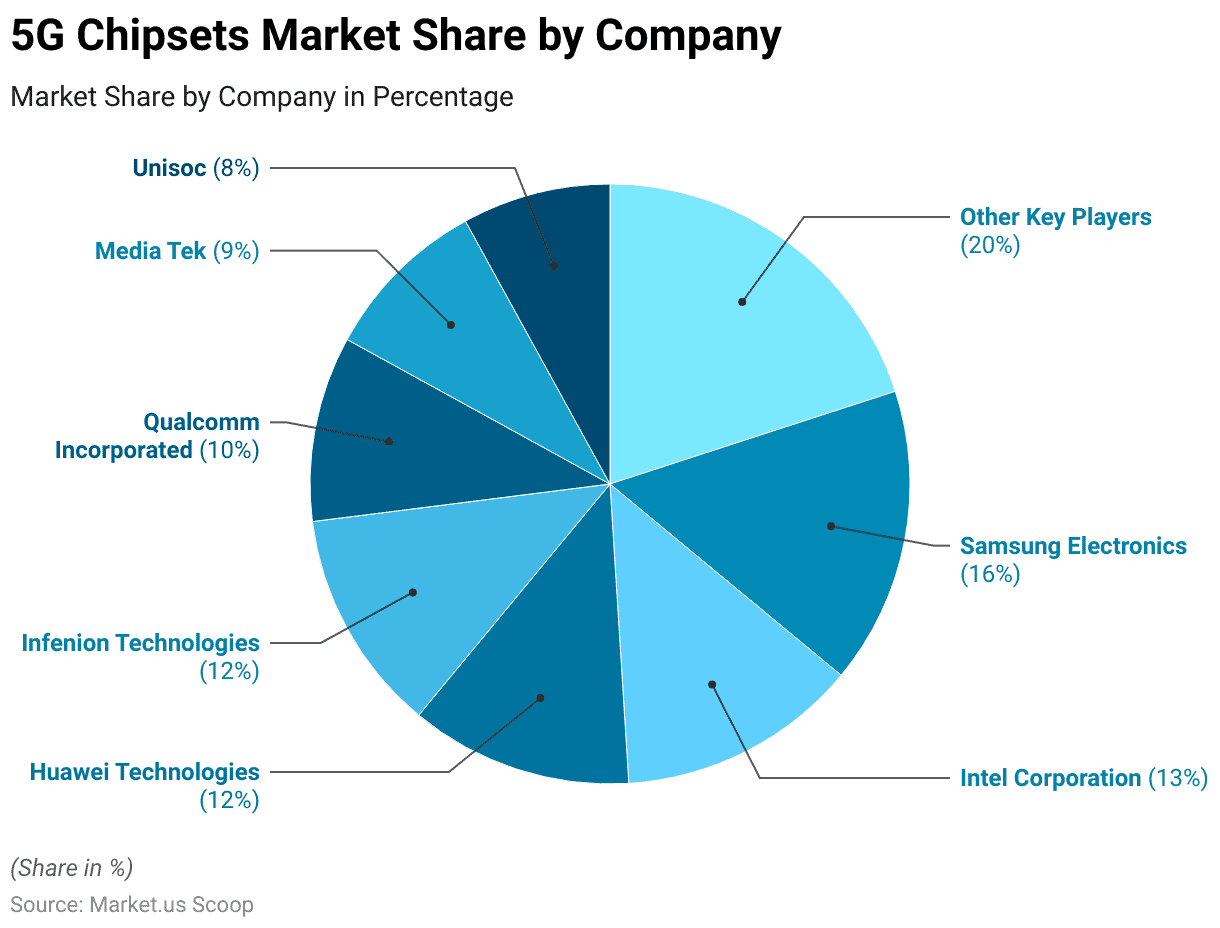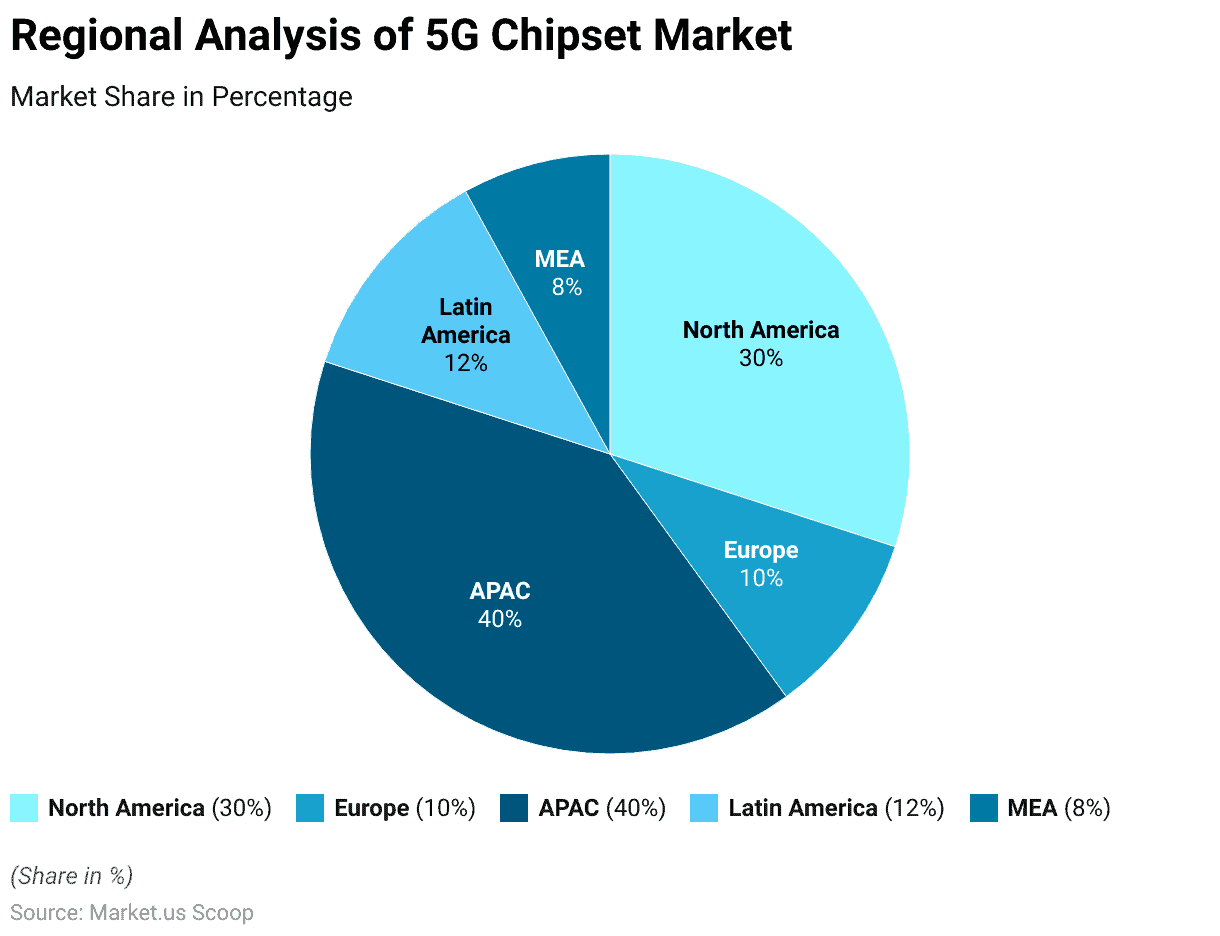Table of Contents
Introduction
According to 5G Chipset Statistics, 5G chipsets play a vital role in 5G networks, serving as the central processing units for communication. These chipsets consist of essential components like modems, baseband processors, and RF front-ends, allowing them to handle high data speeds, minimize delays, and work with different frequency bands, including sub-6 GHz and millimeter-wave.
They’re used in smartphones, IoT devices, automotive tech, and industries, powering features like fast internet, responsive gaming, and autonomous driving. Major semiconductor companies like Qualcomm, MediaTek, Intel, and Samsung lead the way in producing these chipsets.
Challenges include effectively managing heat, signal processing, and network compatibility complexities. Looking ahead, we anticipate 6G development, closer integration with AI, and a growing range of applications across various industries.
Editor’s Choice
- The revenue generated by the 5G chipset market is poised for significant growth in the coming years at a CAGR of 24.67%.
- In 2022, the 5G chipset market recorded a revenue of USD 19.2 billion, projected to steadily rise in the subsequent years.
- Samsung Electronics CO., Ltd. stands out as a frontrunner, commanding a substantial 16% market share.
- North America holds the largest market share, with 30.0%, driven by the rapid deployment of 5G networks and strong consumer demand for high-speed connectivity.
- The MediaTek Helio M70 is a versatile chipset that supports 2G, 3G, 4G, and 5G networks, covering many connectivity options.
- There are three key ISM bands for RF and wireless chips: 902 – 928 MHz, 2.400 – 2.500 GHz, and 5.725 – 5.875 GHz.
- 5G chipsets bring substantially faster data speeds than 4G, boasting peak rates of up to 20 gigabits per second (Gbps).
Global 5G Chipset Market Overview
Global 5G Chipset Market Size
- The revenue generated by the 5G chipset market is poised for significant growth in the coming years at a CAGR of 24.67%.
- In 2022, the market recorded a revenue of USD 19.2 billion, projected to rise in the subsequent years steadily.
- By 2032, the 5G chipset market is projected to hit a remarkable revenue milestone of USD 171.2 billion.

Key Players in the 5G Chipset Market
- Several key players have emerged in the highly competitive 5G chipset market, each vying for a significant share of this rapidly evolving industry.
- Samsung Electronics CO., Ltd. stands out as a frontrunner, commanding a substantial 16% market share.
- Qualcomm Incorporated follows closely behind with a 10% share, known for its pioneering work in wireless technologies.
- Huawei Technologies Co., Ltd. and Infineon Technologies AG share 12% each, emphasizing their global presence and innovative contributions.
- Intel Corporation is also a prominent player with a 13% share, leveraging its expertise in semiconductor technology.
- MediaTek Inc. and Unisoc Communications, Inc. secure 9% and 8%, respectively, showcasing their role in providing 5G solutions.

Regional Analysis of 5G Chipset Market
- The global 5G chipset market is experiencing varying growth across different regions.
- North America holds the largest market share, with 30.0%, driven by the rapid deployment of 5G networks and strong consumer demand for high-speed connectivity.
- In Europe, the market share stands at 10.0%, reflecting a somewhat slower adoption rate than in North America.
- Meanwhile, the Asia-Pacific (APAC) region dominates the market with a substantial 40.0% market share, driven by the sheer size of the population, increasing smartphone penetration, and a strong focus on technological advancements.
- Latin America accounts for 12.0% of the market share, showing potential for growth as 5G infrastructure continues to expand.
- Finally, the Middle East and Africa (MEA) region holds 8.0% of the market share, indicating a growing interest in 5G technology in these regions.

Types of 5G Chipsets
Baseband chipsets
- The 5G baseband chip plays a critical role in managing smartphone networks, and the chip’s quality significantly impacts the strength of mobile signals.
- In essence, the baseband chip is the lifeline enabling smartphone communication. Without this chip, the phone would not connect with the outside world.
- Unisoc’s Full-Netcom single-chip is a versatile solution that provides extensive network support, making it a valuable component in telecommunications.
- This single chip offers compatibility with a wide range of network standards, including TDD NR, FDD NR, FDD-LTE, TDD-LTE, TD-SCDMA, WCDMA, and GSM, ensuring seamless connectivity across various network types.
- It also boasts broad frequency band support, covering global mainstream bands such as Sub-6GHz, including n78, n41, n79, n1, n28, n77, n3, n8, n20, and more.
- Furthermore, it incorporates advanced technologies like VoNR (Voice over New Radio) and VoLTE (Voice over LTE) in 5G Standalone (SA) mode, enhancing the quality and capabilities of voice communication over 5G networks.
RF (Radio Frequency) chipsets
- A 5G RF (Radio Frequency) chipset refers to the components and integrated circuits responsible for handling the radio frequency signals in 5G communication. These chipsets are a crucial part of 5G devices and are significant in ensuring reliable and high-performance wireless communication in 5G networks.
- RF and wireless chip specifications cover supply voltage, data rate, sensitivity, power usage, and operating temperature.
- Other crucial factors include the Industry, Science, and Medicine (ISM) bands and integrated circuit (IC) packaging type.
- There are three key ISM bands for RF and wireless chips: 902 – 928 MHz, 2.400 – 2.500 GHz, and 5.725 – 5.875 GHz.
- Various IC packaging options exist, such as ball-grid array (BGA), flip-chip ball-grid array (FCBGA), plastic ball-grid arr anday (PBGA), multi-chip module plastic ball-grid array (MCM-PBGA), super ball-grid array (SBGA), tape ball-grid array (TBGA), pin-grid array (PGA), ceramic pin-grid array (CPGA), plastic pin-grid array (PPGA), and flip-chip pin-grid array (FCPGA).
Modem chipsets
- 5G modem chipsets are a specialized category designed to enable high-speed, low-latency connectivity to 5G networks.
- Hi-Silicon, a division of Huawei, has two generations of cellular modems in its lineup.
- The first-generation Balong 5G01 modem is exclusively designed for 5G connectivity, while the second-generation Balong 5000 modems offer support for both LTE and 5G networks.
- They also offer a 5G version of their Kirin processor, the Kirin 990.
- Mediatek boasts the Helio M70 modem and a versatile multi-mode 5G system-on-chip that includes the M70 modem.
- Qualcomm brings the Snapdragon 855 and 855+ mobile platforms, complemented by the Snapdragon X50 and X55 modems.
- Samsung introduced the Exynos 5100 (S5T5100) modem and recently revealed the Exynos 980 mobile processor and the complementary Exynos 5123 modem.
Key Features and Specifications
Frequency Bands
- According to 3GPP standards, the first frequency range spans from 410 MHz to 7125 MHz, commonly called the sub-7 GHz or sub-6 GHz spectrum.
- This range is employed for WLAN and LTE/LTE-Advanced technologies and generally lacks major RF complications.
- However, it suffers from congestion due to extensive usage.
- The other band encompasses approximately 30 to 100 GHz, with 3GPP delineating it between 24250 MHz and 52600 MHz, known as the (mmWave) or millimeter band.
- This band boasts ample bandwidth for large-capacity, high-speed data transmission, primarily because it is underutilized.
Data Rates
- 5G chipsets bring substantially faster data speeds than 4G, boasting peak rates of up to 20 gigabits per second (Gbps).
- In the U.S., T-Mobile recorded an average 5G download speed of 186.3 Mbit/s, while South Korea leads globally with an average speed of 432 megabits per second (Mbps).
- Additionally, 5G networks are engineered to provide much greater capacity than 4G, with an anticipated 100-fold increase in network efficiency.
- The prevalent form of 5G, known as sub-6 GHz 5G or mid-band, can deliver data rates ranging from 10 to 1,000 Mbps and offers broader coverage than mmWave bands.
- In 2022, C-Band (n77/n78) deployment occurred among various U.S. operators within the sub-6 bands.
Latency
- 5G chipset offers substantially reduced latency, providing instant, real-time access with a tenfold decrease in end-to-end latency to just one millisecond (ms).
- Release 16 enhances the foundation for 5G Ultra-Reliable Low-Latency Communication (eURLLC), aiming to achieve even greater link reliability, with rates as high as 99.9999 percent.
- To cater to scenarios demanding minimal latency and maximum reliability, known as ultra-reliable low-latency communication (URLLC) applications, 3GPP has improved the cellular interface, enhancing both latency and reliability.
- Implementing 5G is expected to necessitate a significant geographical expansion of the cloud infrastructure, as having a single data center in one location will likely result in unacceptable latency for most other locations.
5g Chipset Energy Efficiency
- As per findings from global technology intelligence firm ABI Research, a 5G base station consumes three times more energy than a 4G network to provide equivalent coverage, resulting in substantial energy expenses and capital investments for network operators.
- However, ABI Research indicates that hardware optimization efforts will significantly reduce power consumption, with the latest chipset generation offering typical energy savings ranging from 30% to 70%.
- The energy consumption of 5G is influenced by factors such as radio setup, hardware, and traffic load, with over 70% of energy consumption occurring within the Radio Access Network (RAN).
- In a typical scenario, a 5G RAN consumes up to 2.7 kilowatts (kW) of power with 64T64R mMIMO configurations, whereas a Long-Term Evolution (LTE) radio consumes approximately 0.8 kW.
Government Regulations Related to 5G Technology
- In recent years, the U.S. government has made significant efforts to ensure that the 5G spectrum is readily available and to expedite the deployment of 5G technology.
- Notably, they repurposed 70 MHz of the 600 MHz spectrum for mobile use through the broadcast incentive auction, addressing the low-band spectrum.
- Furthermore, the FCC has actively conducted auctions for 70 MHz of priority access licenses within the 3.5 GHz band, with a particular focus on the mid-band spectrum, and these auctions took place in June 2020.
- Additionally, the FCC is exploring options to make the C-band spectrum, from 3.7 GHz to 4.2 GHz, accessible for 5G use shortly.
- Moreover, the NTIA has initiated a study to evaluate the feasibility of allowing commercial operations within the 3.45-3.5 GHz band.
- In the high-band domain, the FCC has conducted auctions for significant portions of the millimeter-wave spectrum, recently completing auctions for the 28 GHz and 24 GHz bands.
Discuss your needs with our analyst
Please share your requirements with more details so our analyst can check if they can solve your problem(s)



